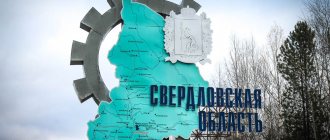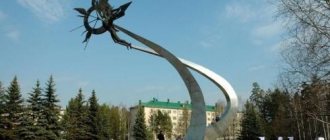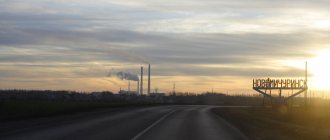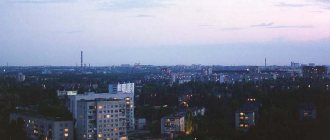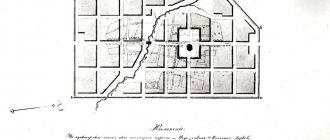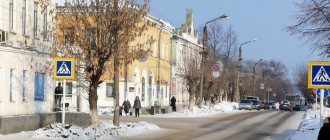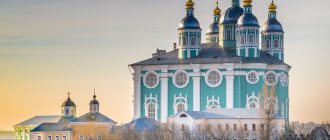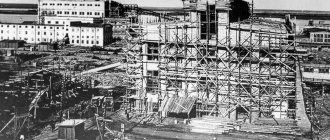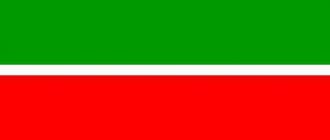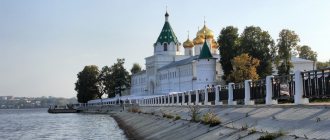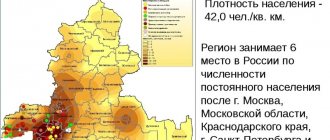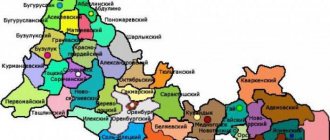| City | |
| Dir | |
| Flag | Coat of arms |
Moscow
Ekaterinburg
Dir
Media files on Wikimedia CommonsThis term has other meanings, see Dir (meanings).
Dir
- a city in the Sverdlovsk region of the Russian Federation, the administrative center of the Rezhevsky urban district.
History[ | ]
| The section lacks links to sources. Information must be verifiable or it may be deleted. You can edit the article to add links to authoritative sources. This mark is set on November 20, 2022 . |
Name based on location on the Rezh River (Tura basin). The etymology of the hydronym is unclear: in the Mangazeya monuments of the 17th century the word dir
- “duct”, but the linguistic affiliation of this word has not been established. There is a version that the word “Rezh” in the language of the ancient Mansi (Finno-Ugric language group) means “rocky shores”. Indeed, there are over 60 large rocks on the Rezh River, thanks to which the river is considered one of the most beautiful in the Urals. In the 1990s, according to Voronov’s directory, the river was among the 100 best rivers in Russia for water travel.
It was founded as a village in 1773 after Savva Yakovlevich Yakovlev received permission from the Berg College to build an iron smelting and ironworks plant in the upper reaches of the Rezh River. At the end of the 18th century, Savva Yakovlev was the largest Russian entrepreneur, and the Rezhevsky plant was his largest brainchild (in total, Savva built 6 factories in the Urals and also bought 16 factories). Production at the plant reached its peak under Savva’s grandson, Alexei Yakovlev (1804-1849). At this time, the quality of Rezhevsky roofing iron was considered standard, which was written about in 1835 in the magazine “Mining Business”, and in 1824, during his stay in Yekaterinburg, Emperor Alexander I himself admired it. Craftsmen from neighboring factories went to the Rezhevsky plant to gain experience districts. In 1878, at the World Industrial Exhibition in Paris, a sheet of Rezhev’s iron was awarded a gold medal, and the master who made it received an expensive caftan from the owner’s shoulder.
Administratively, it was part of the Rezhevskaya volost of the Yekaterinburg district.
At the beginning of the 20th century, a crisis began at the Rezhevsky plant, as well as throughout the Ural metallurgy. In 1911, the Rezhevsky plant closed. The First World War, then the Civil War, and the difficulties of the post-revolutionary period significantly worsened the life of the Rezhelev residents.
On January 16, 1918, the regional Council of Workers' and Soldiers' Deputies, by its resolution, declared all enterprises of the "joint-stock company of V. Isetsky Mining and Mechanical Plants (successors of S. Yakovlev)" public property.
The first report of the presence of nickel ores in the Rezha region came in 1924 from engineer F.M. Kondykin, who examined the Golendukhinskoye iron ore deposit.
Since 1930, the geological exploration bureau of the Ufaleysky Nickel Plant began exploration for nickel ores in the Rezha area. As a result of the search, two deposits of oxidized nickel ores are identified: Golendukhinskoye (12 km from Rezh) and Pokrovskoye (6 km from Rezh). The Rezhevsky Nickel Plant became the second enterprise in the young nickel industry in the Soviet Union after the Ufaleysky Plant.
The city is divided into the microdistricts “Seven Winds”, “Gavan”, “Sixth Section”, “Stroygorodok”, “Vokzal”, “Kochnevo”.
The annual celebration of City Day is the first Saturday in July.
On February 1, 1963, Rezh was classified as a city of regional subordination, and the Council of Workers' Deputies of the city was transferred to the subordination of the Sverdlovsk Regional Council of Workers' Deputies[2].
Ekaterinburg
The list of cities in the Sverdlovsk region must begin with the capital of the region, Yekaterinburg. It currently has a population of 1 million 455 thousand people. In fact, this is a quarter of the population of the entire region.
Yekaterinburg is located in the eastern part of the Middle Urals, directly on the banks of the Iset River. The city appeared on this site in 1723 after the appearance of an ironworks in these places. Since then it has been one of the main industrial centers of Russia. It received its name in honor of Empress Catherine II, who in 1781 granted it the status of a county town within the Perm province. Back then, few could imagine that it would be one of the Russian cities with a population of over a million.
At the turn of the 19th and 20th centuries, the city became one of the centers of the Russian revolutionary movement in the Urals, and during the war against the Nazis it played an important role in supplying the Red Army with ammunition and armored vehicles, which were produced at the local heavy engineering plant.
In the list of cities in the Sverdlovsk region by population, this is the largest city. Moreover, it ranks fourth in all of Russia, behind only Moscow, St. Petersburg and Novosibirsk.
Ekaterinburg is one of the six hundred largest cities on the planet, producing 60% of global GDP. There is a large transport and logistics hub and an important industrial center here. In 2018, the city hosted matches of the FIFA World Cup in Russia.
To get a complete picture of the region, it doesn’t hurt to familiarize yourself with the complete alphabetical list of cities in the Sverdlovsk region. It looks like this:
- Alapaevsk, Aramil, Artemovsky, Asbest,
- Berezovsky, Bogdanovich,
- Verkhny Tagil, Verkhnyaya Pyshma, Verkhnyaya Salda, Verkhnyaya Tura, Verkhoturye, Volchansk,
- Degtyarsk,
- Ekaterinburg,
- Zarechny,
- Ivdel, Irbit,
- Kamensk-Uralsky, Kamyshlov, Karpinsk, Kachkanar, Kirovograd, Krasnoturinsk, Krasnouralsk, Krasnoufimsk, Kushva,
- Forest,
- Mikhailovsk,
- Nevyansk, Nizhny Sergi, Nizhny Tagil, Nizhnyaya Salda, Nizhnyaya Tura, Nizhnyaya Lyalya, Novouralsk,
- Pervouralsk, Polevskoy,
- Revda, Dir,
- Severouralsk, Serov, Sredneuralsk, Sukhoi Log, Sysert,
- Tavda, Talitsa, Turinsk.
Now you know what the alphabetical list of cities in the Sverdlovsk region looks like. In this article you will learn more about only the most densely populated areas.
Population[ | ]
| Population | ||||||||
| 1959[3] | 1967[4] | 1970[5] | 1979[6] | 1989[7] | 1992[4] | 1996[4] | 1998[4] | 2000[4] |
| 21 298 | ↗30 000 | ↘29 895 | ↗37 905 | ↗43 429 | ↗44 000 | ↘42 400 | ↘42 000 | ↘41 800 |
| 2001[4] | 2002[8] | 2003[4] | 2005[4] | 2006[4] | 2007[4] | 2008[9] | 2009[10] | 2010[11] |
| ↘41 700 | ↘39 881 | ↗39 900 | ↘39 300 | →39 300 | ↘39 100 | ↘38 900 | ↗38 944 | ↘38 215 |
| 2011[4] | 2012[12] | 2013[13] | 2014[14] | 2015[15] | 2016[16] | 2017[17] | 2018[18] | 2019[19] |
| ↘38 200 | ↘37 949 | ↘37 662 | ↘37 643 | ↗37 706 | ↘37 553 | ↘37 420 | ↘37 152 | ↘36 843 |
| 2020[20] | 2021[1] | |||||||
| ↘36 825 | ↘36 420 | |||||||
As of January 1, 2022, in terms of population, the city was in 426th place out of 1116[21]cities of the Russian Federation[22].
Attractions[ | ]
| The section lacks links to sources. Information must be verifiable or it may be deleted. You can edit the article to add links to authoritative sources. This mark is set on November 20, 2022 . |
A unique “gem strip of the Urals” runs through the region from north to south, from which, according to Academician Fersman, the mineralogical history of Russia began.
On February 13, 1995, the state natural and mineralogical reserve “Rezhevskoy” was established in Rezh. Its main task is the protection of mineralogical objects - old and new mines (amethysts, topazes, emeralds, opal, tourmalines, etc.). More than 60 mines are under protection. It is also a comprehensive reserve for the protection of game species. The Rezhevskaya nature reserve includes the southern part of the Gemstone Strip of the Urals. Within the reserve there are 3 sections: Lipovsky, Shaitansky and Aduisky.
A mineralogical museum has also been created in the city, which organizes excursions to ancient gem mines, where they learn about the technology of stone mining; in addition, tourists search for collectible stones in the dumps. The Rezhevsky Mineralogical Museum is located in the oldest city mansion, which is almost 200 years old (the factory manager's house or the Lord's house) and which is associated with the name of Tit Zotov. The master's house is distinguished by a rotunda and domed top, rare in the Middle Urals[23].
Among the attractions of Rezh is the Church of John the Baptist, the ancient church of the city, consecrated in 1902. The temple was built in the Russian-Byzantine style. Architect Sergei Kozlov and academician of architecture Julius Dutel took part in the development of the church project. When designing the temple, the “exemplary” design of the great K. A. Ton was used[23]. Among the Rezhev factory managers, the most famous was Tit Zotov, whom the writer Mamin-Sibiryak called one of the first kings of Russian gold, who became one of the first heroes of the gold rush that broke out in the Urals and later swept Siberia and North America. The “Proboyny” spring is a place where in ancient times there were Old Believer hermitages. Monument to Labor and Military Glory, a monument to Rezhevsky craftsmen - the founders of the city. The city also has preserved ancient stone and wooden houses, giving the city a historical look. “Five Brothers” rocks, a city pond with picturesque pine-covered rocky shores and many springs. In the vicinity of the city there is the Rezhevsky Ecopark with an eco-trail along the rocky bank of the Rezh River, viewing platforms from the Rezhevsky rocks, recreational beach areas, and landscape museums in Mironovo and Aramashevo.
- Monument to Labor and Military Glory
- Church of John the Baptist
- First school
Kamensk-Uralsky
Kamensk-Uralsky occupies a special place in the list of cities in the Sverdlovsk region. This is another large-scale cultural and industrial center in the Middle Urals, home to almost 170 thousand people.
It is among the top ten largest transport railway junctions in the country. This is where many federal highways and highways intersect. The settlement on the site of Kamensk-Uralsky was founded back in 1682 by direct decree of the Russian Tsar Fyodor Alekseevich, but it acquired the status of a city only in the 20th century, in 1940.
Now the city is going through difficult times, it was even included in the list of Russian single-industry towns with a critical economic situation.
Three quarters of the city’s economy comes from the four largest enterprises - the Sinarsky Pipe Plant, RUSAL, and Metallurgical. Companies in the non-ferrous and ferrous metallurgy, mechanical engineering, and food industries are actively developing in the city.
Industry[ | ]
- IP Kudryavtsev Vitaly Evgenievich - Repair and production site. Welding shop, Auto service, Construction work, Cargo transportation.
- CJSC PA "Rezhnikel" (not operating since 2017)[24]
- Rezhevsky Mechanical Plant (not working)[25][26]
- CJSC "Rezhevsky Cable Plant"
- Rezhevskaya garment factory.
- In the suburb of Rezh-1 (Bystrinsky village) there was the Rezhevsky Chemical Plant (RHZ). In 2003, he went bankrupt because he was unable to work in a market economy.
- Rezhevsk Concrete Concrete Plant.
- Rezhevsky crushed stone plant.
- Glinsky quarry.
- Quarry and mine of Safyanovskaya Med JSC (part of the UMMC holding).
- OJSC "Rezhevskaya Bread Factory" - production of bakery and confectionery products under the "Rezhkhleb" trademark, popular in the Sverdlovsk region. The products are distributed throughout the Middle Urals[27] and receive awards at the federal level[28], the plant is among the 100 best food industry enterprises in Russia[29].
- LLC NPO "Experimental Plant" - production of agricultural equipment, equipment for stone processing, railway equipment, non-standard equipment.
- LLC - production of engineering products, non-standard equipment.
- Shnitki LLC is a children's clothing factory.
- LLC "Transformator-Rezh Plant" - production of power oil transformers and complete transformer substations.
- Elix LLC is the largest manufacturer of PVC pipes.
Novouralsk
There is a fairly large settlement on the list of closed cities in the Sverdlovsk region - Novouralsk. It is home to about 81.5 thousand inhabitants.
The city was formed in 1941 after a light alloy plant began to be built in the vicinity of the modern settlement. In 1954, Novouralsk received city status. Remains one of 40 closed cities in Russia and one of ten owned by Rosatom.
The largest enterprises are the Ural Electrochemical Plant and the Novouralsk Instrument Plant. In recent years, the construction of multi-storey comfortable residential buildings has been actively developing in the city. It is noteworthy that most construction sites are located directly in the very center of the city. In addition, it is one of the largest energy centers located in the Northern Urals. Agriculture plays a significant role in the local economy.
Cities of the Sverdlovsk region: list by population on News4Auto.ru.
Our life consists of everyday little things that in one way or another affect our well-being, mood and productivity. I didn’t get enough sleep - my head hurts; I drank coffee to improve the situation and cheer myself up - I became irritable. I really want to foresee everything, but I just can’t. Moreover, everyone around, as usual, gives advice: gluten in bread - don’t go near it, it will kill you; A chocolate bar in your pocket is a direct path to tooth loss. We collect the most popular questions about health, nutrition, diseases and give answers to them that will allow you to better understand what is good for your health.
Culture[ | ]
- Mineralogical Museum “Gem Strip of the Urals” (Sovetskaya St., 4).
- Historical Museum (Krasnoarmeyskaya St., 3).
- Municipal budgetary cultural institution “Palace of Culture “Metallurg”” (Kostousova St., 82).
- Municipal budgetary cultural institution “Palace of Culture “Horizon”” (Kalinina St., 47).
- Municipal budgetary cultural institution Center for Culture and Arts (Lenin St., 2).
- Municipal government cultural institution “Center of National Cultures” (Krasnoflotsev St., 7).
- MBOU DOD "Rezhevskaya Children's School of Arts" (Kalinina St., 19a, Kosmonavtov St., 1, Krasnoarmeyskaya St., 7a).
- Central Library (Lenin St., 30)
- Central Children's Library (Lenin St., 30)
- City Library "Gavan" (Zavodskaya St., 3)
- City Library "Bystrinskaya" (O. Koshevogo Lane, 1)
Media[ | ]
Newspapers[ | ]
- "Rezhevskaya news"
- "Rezha's News"
- “Rezhevskaya news. District"
Radio stations[ | ]
| Frequency MHz | Name | RDS | Format | Power [ source not specified 3623 days ], kW | Telecentre | Time |
| 69,17 | Radio Russia / Radio Ural (Silent) | — | News/Talk | 0,1 | RTS | 5-1 |
| 70,13 | Radio Resurrection | — | Orthodox | 0,1 | RTS | 0-24 |
| 88,1 | Wave FM | + | CHR | 0,1 | RTS | 0-24 |
| 91,7 | New radio | — | — | — | — | 0-24 |
| 102,3 | Russian radio | + | Rus CHR / Hot AC | 0,1 | Lenina, 39 | 0-24 |
| 102,8 | Dir Radio | — | — | 0,25 | Shcherbakova, 17 | 0-24 |
| 103,4 | Autoradio | — | — | — | — | 0-24 |
| 105,4 | Europa Plus | + | CHR | 0,1 | Lenina, 39 | 0-24 |
| 107,2 | Radio Russia / Radio Ural | — | News/Talk | 0,1 | RTS2 | 5-1 |
| 107,8 | Jam FM | — | — | — | — | 0-24 |
Notes[ | ]
- ↑ 12
The permanent population of the Russian Federation by municipalities as of January 1, 2022 (Russian). Retrieved April 27, 2022. Archived May 2, 2022. - ipravo.info.
On the consolidation of rural areas, the formation of industrial districts and changes in the subordination of districts and cities of the Sverdlovsk region - Russian Legal Portal (Russian) (inaccessible link). ipravo.info. Retrieved May 20, 2022. Archived May 20, 2018. - All-Union Population Census of 1959. The size of the urban population of the RSFSR, its territorial units, urban settlements and urban areas by gender (Russian). Demoscope Weekly. Access date: September 25, 2013. Archived April 28, 2013.
- ↑ 1234567891011
People's encyclopedia "My City". Dir - All-Union Population Census of 1970 The size of the urban population of the RSFSR, its territorial units, urban settlements and urban areas by gender. (Russian). Demoscope Weekly. Access date: September 25, 2013. Archived April 28, 2013.
- All-Union Population Census of 1979 The size of the urban population of the RSFSR, its territorial units, urban settlements and urban areas by gender. (Russian). Demoscope Weekly. Access date: September 25, 2013. Archived April 28, 2013.
- All-Union population census of 1989. Urban population (undefined)
. Archived from the original on August 22, 2011. - All-Russian population census 2002. Volume. 1, table 4. Population of Russia, federal districts, constituent entities of the Russian Federation, districts, urban settlements, rural settlements - regional centers and rural settlements with a population of 3 thousand or more (unspecified)
. Archived from the original on February 3, 2012. - Administrative-territorial division of the Sverdlovsk region as of January 1, 2008 (undefined)
. Access date: May 11, 2016. Archived May 11, 2016. - The size of the permanent population of the Russian Federation by cities, urban settlements and regions as of January 1, 2009 (unspecified)
. Retrieved January 2, 2014. Archived January 2, 2014. - Number and distribution of the population of the Sverdlovsk region (Russian) (inaccessible link). All-Russian Population Census 2010
. Department of the Federal State Statistics Service for the Sverdlovsk Region and Kurgan Region. Access date: April 16, 2022. Archived September 28, 2013. - Population of the Russian Federation by municipalities. Table 35. Estimated resident population as of January 1, 2012 (unspecified)
. Retrieved May 31, 2014. Archived May 31, 2014. - Population of the Russian Federation by municipalities as of January 1, 2013. - M.: Federal State Statistics Service Rosstat, 2013. - 528 p. (Table 33. Population of urban districts, municipal districts, urban and rural settlements, urban settlements, rural settlements) (undefined)
. Retrieved November 16, 2013. Archived November 16, 2013. - Population of the Russian Federation by municipalities as of January 1, 2014 (Russian). Retrieved October 18, 2022. Archived August 2, 2014.
- Population of the Russian Federation by municipalities as of January 1, 2015 (unspecified)
. Access date: August 6, 2015. Archived August 6, 2015. - Population of the Russian Federation by municipalities as of January 1, 2016 (Russian) (October 5, 2018). Retrieved May 15, 2022. Archived May 8, 2022.
- Population of the Russian Federation by municipalities as of January 1, 2022 (Russian) (July 31, 2017). Retrieved July 31, 2022. Archived July 31, 2022.
- Population of the Russian Federation by municipalities as of January 1, 2022 (Russian). Retrieved July 25, 2018. Archived July 26, 2022.
- Population of the Russian Federation by municipalities as of January 1, 2022 (Russian). Retrieved July 31, 2019. Archived May 2, 2022.
- Population of the Russian Federation by municipalities as of January 1, 2022 (Russian). Date accessed: October 17, 2022. Archived October 17, 2022.
- taking into account the cities of Crimea
- https://rosstat.gov.ru/storage/mediabank/bul_Chislen_nasel_MO-01-01-2021.rar Population of the Russian Federation by municipalities as of January 1, 2022 (1.85 Mb, 07/30/2021)
- ↑ 1 2
Tour of Rezh: history and sights of the city - (Russian)
(undefined)
.
To the holy places of the Urals
. Access date: October 19, 2022. - | Rezhnikel was declared bankrupt due to a debt of 16 billion rubles
- | Rezhevsky Mechanical Plant may stop work on April 7
- | “Haunted House” is for sale in Rezh
- The Ministry of Agriculture threatens the owner of Rezh-Khleb - Ystav.com (unspecified)
(inaccessible link). Retrieved March 16, 2016. Archived March 21, 2016. - “Rezh-Khleb” received gold in Moscow - Ystav.com (unspecified)
(inaccessible link). Retrieved March 16, 2016. Archived March 21, 2016. - REGION-MEDIA | About the agency (unspecified)
(inaccessible link). Retrieved March 16, 2016. Archived March 21, 2016.
Nizhny Tagil
The next largest city in the Sverdlovsk region is Nizhny Tagil. Its population is 355.5 thousand people. This is the most important cultural and industrial center not only of the Sverdlovsk region, but also of the entire Urals. The economic indicators are simply amazing. The number of goods sold produced in the city in manufacturing industries alone exceeds 130 billion rubles per year. Surprisingly, according to this statistical indicator, Nizhny Tagil is a leader in the entire region, ahead of even Yekaterinburg.
The largest enterprises are the Nizhny Tagil Metallurgical Plant, Uralvagonzavod, and OJSC Uralkhimplast. These industries employ a significant number of local residents.
